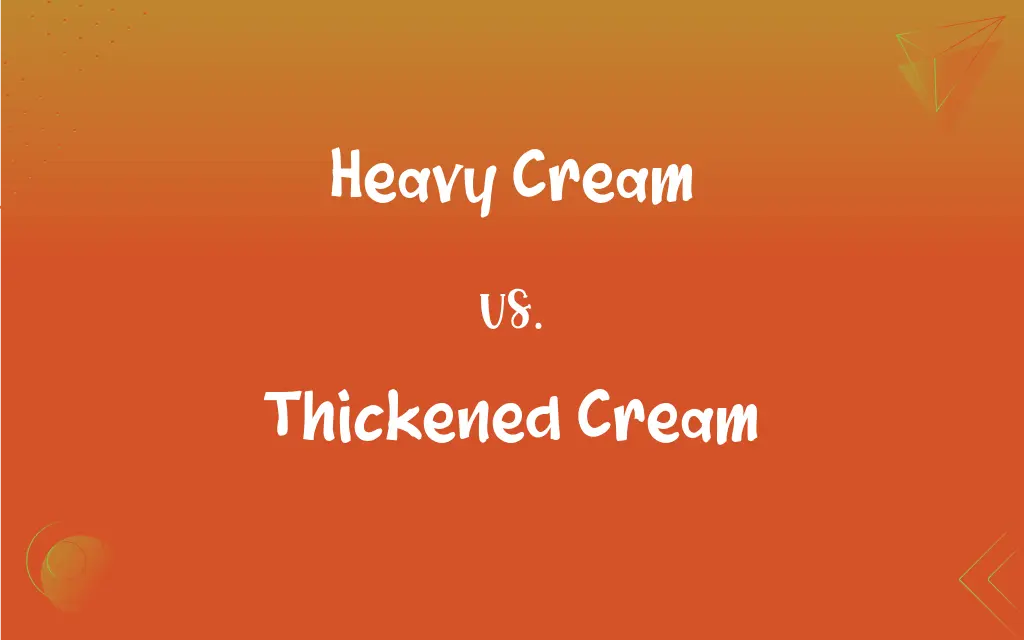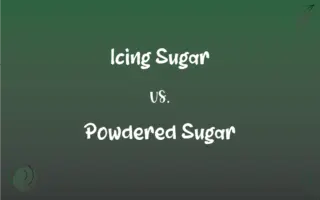Heavy Cream vs. Thickened Cream: What's the Difference?
Edited by Janet White || By Harlon Moss || Updated on October 9, 2023
Heavy cream and thickened cream are both high-fat dairy products, but heavy cream is slightly richer with at least 36% milk fat, while thickened cream includes gelatin or other thickeners and has about 35% milk fat.

Key Differences
Heavy cream and thickened cream both occupy a vital space in the culinary world, especially in baking and sauce creation. Heavy cream, known for its rich and luscious texture, usually contains a higher fat percentage, at least 36%, which facilitates a stable structure when whipped. On the other hand, thickened cream, a favorite among numerous chefs and home cooks, typically contains around 35% milk fat and has thickeners like gelatin or vegetable gums added, which guarantees a consistently dense texture.
Heavy cream is famed for its ability to be whipped to stiff peaks, becoming a key ingredient in recipes like whipped cream and ice cream. It boasts a smooth, luxurious texture and an inherently rich flavor, making it a preferable choice for certain dishes that demand a creamy consistency. Conversely, thickened cream, owing to the additional thickening agents, is already a bit denser than its counterpart, which can be advantageous in recipes requiring a stable, robust creaminess, such as soups and sauces, without the necessity of being whipped.
An intriguing aspect of heavy cream is its capability to create a velvety mouthfeel in various dishes, including soups, sauces, and desserts, thanks to its higher fat content. Thickened cream, however, may not impart as rich a mouthfeel as heavy cream but offers the benefit of an already somewhat stabilized structure, which can be especially useful in dishes that require a cream to hold its shape or consistency for a longer period.
In terms of availability, heavy cream is more commonly found and utilized in the United States, where it's often a staple in various traditional American desserts and dishes. In contrast, thickened cream is predominantly used and available in countries like Australia and the UK, where it's a go-to cream for many local recipes, including desserts and savory dishes, providing them with a distinctly hearty and creamy consistency.
When it comes to choosing between heavy cream and thickened cream, the selection often hinges on the specific requirements of a recipe and, at times, regional availability. Some recipes might specifically call for the rich, luxurious quality of heavy cream, while others may necessitate the reliable, stable texture offered by thickened cream. Chefs and home cooks may find that having an understanding of each cream’s unique characteristics can guide them towards making informed, suitable substitutions when necessary.
ADVERTISEMENT
Comparison Chart
Fat Content
Minimum 36%
About 35%
Thickeners
No added thickeners
Contains thickeners like gelatin
Whipping Quality
Can be whipped to stiff peaks
May not hold peaks as firmly
Common Usage
Predominantly in the USA
Often in Australia and the UK
Best Used In
Dishes requiring a rich texture
Recipes needing stable creaminess
ADVERTISEMENT
Heavy Cream and Thickened Cream Definitions
Heavy Cream
Heavy cream is a high-fat dairy product.
The heavy cream added a lush richness to the soup.
Thickened Cream
It tends to have a sturdier texture.
The pasta sauce benefitted from the sturdier texture of thickened cream.
Heavy Cream
Heavy cream can be whipped to stiff peaks.
The heavy cream was whipped to create a fluffy topping for the dessert.
Thickened Cream
Thickened cream is widely used in Australia.
In Australia, thickened cream is often poured over traditional puddings.
Heavy Cream
It contains at least 36% milk fat.
Due to having over 36% milk fat, the heavy cream whipped up beautifully.
Thickened Cream
Thickened cream contains around 35% milk fat.
The thickened cream provided a stable, hearty base for the sauce.
Heavy Cream
Heavy cream has a rich, velvety texture.
The heavy cream added a luxurious, velvety mouthfeel to the chocolate ganache.
Thickened Cream
Thickened cream is often used without whipping.
The thickened cream was directly added to the soup without needing to be whipped first.
Heavy Cream
It is often used in American cuisine.
The recipe called for heavy cream to create a classic American alfredo sauce.
Thickened Cream
It includes thickeners like gelatin.
The thickened cream, with its added gelatin, held its shape well in the dessert.
FAQs
What is the main difference between heavy cream and thickened cream?
Heavy cream has a higher fat content and no thickeners, while thickened cream has slightly less fat and includes thickeners.
Can I use heavy cream and thickened cream interchangeably?
It depends on the recipe, but in some cases, they can be substituted for each other with consideration of texture and stability differences.
Which cream is more popular in American recipes?
Heavy cream is more commonly utilized in American recipes.
Which cream should I choose for a more stable, robust creaminess in my dishes?
Thickened cream, due to its additives, typically offers a more stable and robust creaminess.
Which cream is typically used in sauces like Alfredo?
Heavy cream is commonly used in creamy sauces like Alfredo due to its rich and velvety texture.
Can I use half-and-half as a substitute for heavy cream?
Half-and-half can be used as a lighter substitute, but it will not provide the same richness or have the same whipping properties as heavy cream.
Is heavy cream suitable for whipping?
Yes, heavy cream whips well due to its high fat content.
What can I substitute for heavy cream if I want a dairy-free option?
Coconut cream is a popular dairy-free alternative to heavy cream.
Is one type of cream healthier than the other?
Both are high in fat and calories, so neither is significantly healthier, but exact healthiness can depend on specific dietary needs and the specific products available to you.
Can I whip thickened cream for my desserts?
Yes, thickened cream can also be whipped, though it may not hold peaks as firmly as heavy cream.
Can I use heavy cream in my coffee?
Yes, heavy cream can be used in coffee, providing a rich and creamy taste.
How does the usage of thickened cream vary in British or Australian cooking compared to American cooking?
Thickened cream is more commonly utilized in British and Australian cooking, often in both sweet and savory dishes, whereas American cooking frequently employs heavy cream.
Which cream is preferable for making ice cream?
Heavy cream is often preferred for making ice cream due to its ability to be whipped to stiff peaks and its rich flavor.
Is the taste of heavy cream and thickened cream significantly different?
Both have a creamy flavor, but heavy cream might be perceived as richer due to its higher fat content.
Is thickened cream naturally thick or does it contain additives?
Thickened cream usually contains additives like gelatin to enhance its consistency.
How should I store leftover cream?
Both heavy and thickened cream should be refrigerated and used within a few days of opening.
Can I use heavy cream in place of thickened cream in a soup recipe?
Yes, you can use heavy cream, but the soup might have a slightly richer and creamier texture compared to using thickened cream.
Which cream is favored in pastry-making?
It depends on the recipe; heavy cream might be chosen for its richness, while thickened cream might be chosen for its stability.
Can I freeze leftover cream for later use?
Both heavy cream and thickened cream can be frozen, but it may affect their texture and whipping qualities upon thawing.
Can I make homemade thickened cream?
Yes, you can simulate thickened cream by adding a stabilizer like gelatin to regular cream.
About Author
Written by
Harlon MossHarlon is a seasoned quality moderator and accomplished content writer for Difference Wiki. An alumnus of the prestigious University of California, he earned his degree in Computer Science. Leveraging his academic background, Harlon brings a meticulous and informed perspective to his work, ensuring content accuracy and excellence.
Edited by
Janet WhiteJanet White has been an esteemed writer and blogger for Difference Wiki. Holding a Master's degree in Science and Medical Journalism from the prestigious Boston University, she has consistently demonstrated her expertise and passion for her field. When she's not immersed in her work, Janet relishes her time exercising, delving into a good book, and cherishing moments with friends and family.































































